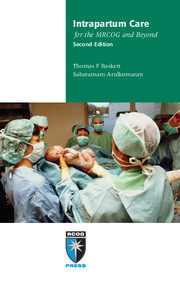Book contents
- Frontmatter
- Contents
- Preface
- Abbreviations
- 1 Improving intrapartum care
- 2 First stage of labour
- 3 Second stage of labour
- 4 Fetal surveillance in labour
- 5 Third stage of labour
- 6 Lower genital tract trauma
- 7 Induction of labour
- 8 Preterm labour and prelabour rupture of membranes
- 9 Assisted vaginal delivery
- 10 Shoulder dystocia
- 11 Breech vaginal delivery
- 12 Twin and triplet delivery
- 13 Caesarean section
- 14 Vaginal birth after caesarean section
- 15 Uterine rupture
- 16 Emergency obstetric hysterectomy
- 17 Cord prolapse
- 18 Antepartum haemorrhage
- 19 Postpartum haemorrhage
- 20 Acute uterine inversion
- 21 Amniotic fluid embolism
- 22 Disseminated intravascular coagulation
- 23 Acute tocolysis
- 24 Severe pre-eclampsia and eclampsia
- 25 Neonatal resuscitation
- 26 Perinatal loss: management of late fetal death and stillbirth
- Index
8 - Preterm labour and prelabour rupture of membranes
Published online by Cambridge University Press: 05 July 2014
- Frontmatter
- Contents
- Preface
- Abbreviations
- 1 Improving intrapartum care
- 2 First stage of labour
- 3 Second stage of labour
- 4 Fetal surveillance in labour
- 5 Third stage of labour
- 6 Lower genital tract trauma
- 7 Induction of labour
- 8 Preterm labour and prelabour rupture of membranes
- 9 Assisted vaginal delivery
- 10 Shoulder dystocia
- 11 Breech vaginal delivery
- 12 Twin and triplet delivery
- 13 Caesarean section
- 14 Vaginal birth after caesarean section
- 15 Uterine rupture
- 16 Emergency obstetric hysterectomy
- 17 Cord prolapse
- 18 Antepartum haemorrhage
- 19 Postpartum haemorrhage
- 20 Acute uterine inversion
- 21 Amniotic fluid embolism
- 22 Disseminated intravascular coagulation
- 23 Acute tocolysis
- 24 Severe pre-eclampsia and eclampsia
- 25 Neonatal resuscitation
- 26 Perinatal loss: management of late fetal death and stillbirth
- Index
Summary
Preterm birth is defined as delivery before the 37th completed week of gestation; there is no definitive definition of the lower limit. The World Health Organization considers a fetus over 22 weeks of gestation at the limit of viability. In the absence of known gestation, a birth weight of 500 g has been considered potentially compatible with life. Available data show the mortality rate to be high up to 24 weeks of gestation; therefore, many countries, including the UK, consider 24 weeks as the cut-off point for fetal viability. Births between 24 and 37 weeks of gestation account for 5–12% of total deliveries. Rates of preterm birth differ from country to country and from region to region within countries, depending on the definitions used. Although there are a relatively small number of preterm births, they contribute to nearly 70% of all perinatal deaths. Mortality and neurological morbidity are greater at early gestations and much lower after 28 weeks of gestation. The long-term handicap may manifest as blindness, deafness or cerebral palsy, in addition to chronic respiratory disorders. The majority of women who present with uterine contractions in the preterm period do not progress to established labour. Hence, more women than necessary may be treated with tocolytics to prevent or abolish uterine contractions and with corticosteroids to enhance fetal lung maturity. Management varies based on whether the woman presents in preterm labour with or without prelabour rupture of membranes. This chapter covers preterm labour and prelabour rupture of membranes preterm and at term.
- Type
- Chapter
- Information
- Intrapartum Care for the MRCOG and Beyond , pp. 85 - 98Publisher: Cambridge University PressPrint publication year: 2011



